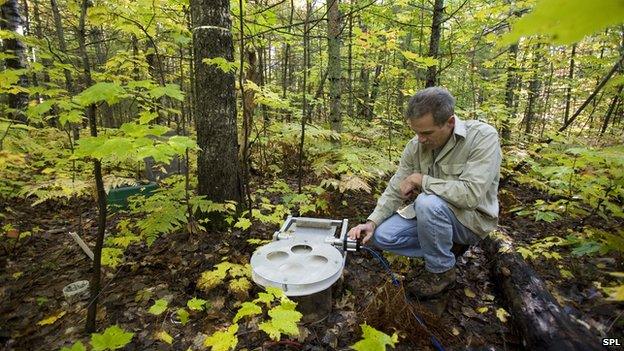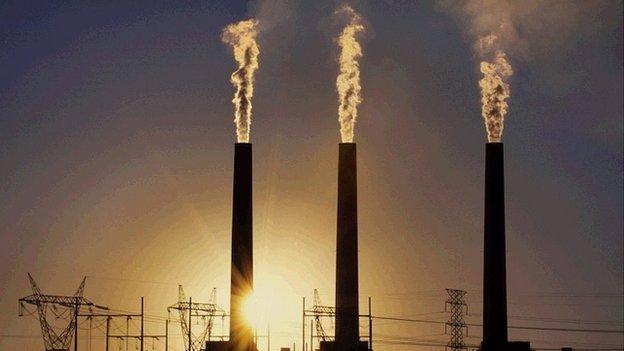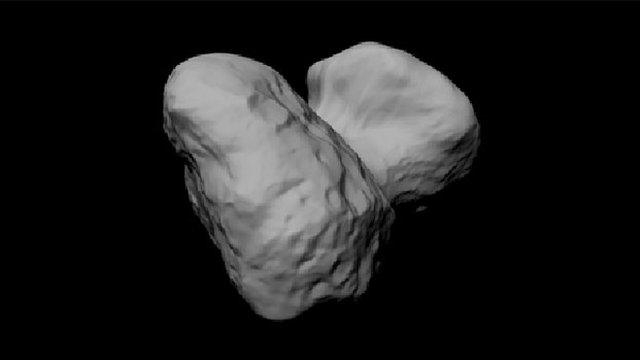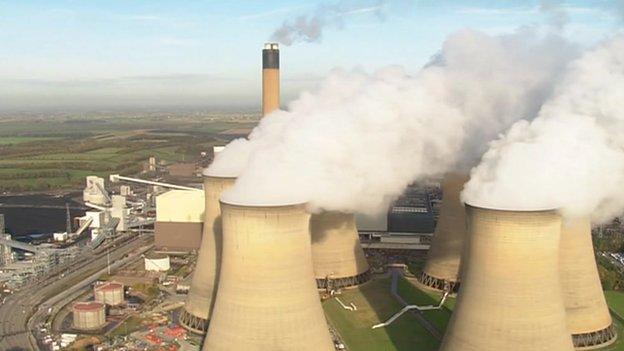Climate change: Models 'underplay plant CO2 absorption'
- Published

Leaves absorb significantly more CO2 than climate models have estimated
Global climate models have underestimated the amount of CO2 being absorbed by plants, according to new research.
Scientists say that between 1901 and 2010, living things absorbed 16% more of the gas than previously thought.
The authors say it explains why models consistently overestimated the growth rate of carbon in the atmosphere.
But experts believe the new calculation is unlikely to make a difference to global warming predictions.
The research has been published, external in the journal Proceedings of the National Academy of Sciences.
Working out the amount of carbon dioxide that lingers in the atmosphere is critical to estimating the future impacts of global warming on temperatures.
About half the CO2 that's produced ends up in the oceans or is absorbed by living things.
But modelling the exact impacts on a global scale is a fiendishly complicated business.
In this new study, a team of scientists looked again at the way trees and other plants absorb carbon.
By analysing how CO2 spreads slowly inside leaves, a process called mesophyll diffusion, the authors conclude that more of the gas is absorbed than previously thought.
Between 1901 and 2100 the researchers believe that their new work increases the amount of carbon taken up through fertilisation from 915 billion tonnes to 1,057 billion, a 16% increase.
"There is a time lag between scientists who study fundamental processes and modellers who model those processes in a large scale model," explained one of the authors, Dr Lianhong Gu at Oak Ridge National Laboratory in the US.
"It takes time for the the two groups to understand each other."

Scientists monitor carbon dioxide levels near trees to work out how much is absorbed
The researchers believe that Earth system models have over-estimated the amount of carbon in the atmosphere by about 17%, and think their new evaluation of plant absorption explains the gap.
"The atmospheric CO2 concentration only started to accelerate rapidly after 1950," said Dr Gu.
"So the 17% bias was achieved during a period of about 50 years. If we are going to predict future CO2 concentration increases for hundreds of years, how big would that bias be?"
Model revamp
Other researchers believe the new work could help clarify our models but it may not mean any great delay in global warming as a result of increased concentrations of the gas.
"The paper provides great new insights into how the very intricacies of leaf structure and function can have a planetary scale impact," said Dr Pep Canadell from the Global Carbon Project at CSIRO Australia.
"It provides a potential explanation for why global earth system models cannot fully reproduce the observed atmospheric CO2 growth over the past 100 years and suggests that vegetation might be able to uptake more carbon dioxide in the future than is currently modelled.
"Having more carbon taken up by plants would slow down climate change but there are many other processes which lay in between this work and the ultimate capacity of terrestrial ecosystems to remove carbon dioxide and store it for long enough to make a difference to atmospheric CO2 trends."
Many experts agree that the effect is interesting and may require a recalibration of models - but it doesn't change the need for long-term emissions cuts to limit the impact of carbon dioxide.
"This new research implies it will be slightly easier to fulfil the target of keeping global warming below two degrees - but with a big emphasis on 'slightly'," said Dr Chris Huntingford, a climate modeller at the UK's Centre for Ecology and Hydrology.
"Overall, the cuts in CO2 emissions over the next few decades will still have to be very large if we want to keep warming below two degrees."
Follow Matt on Twitter @mattmcgrathbbc.
- Published21 September 2014

- Published3 October 2014

- Published22 September 2014
